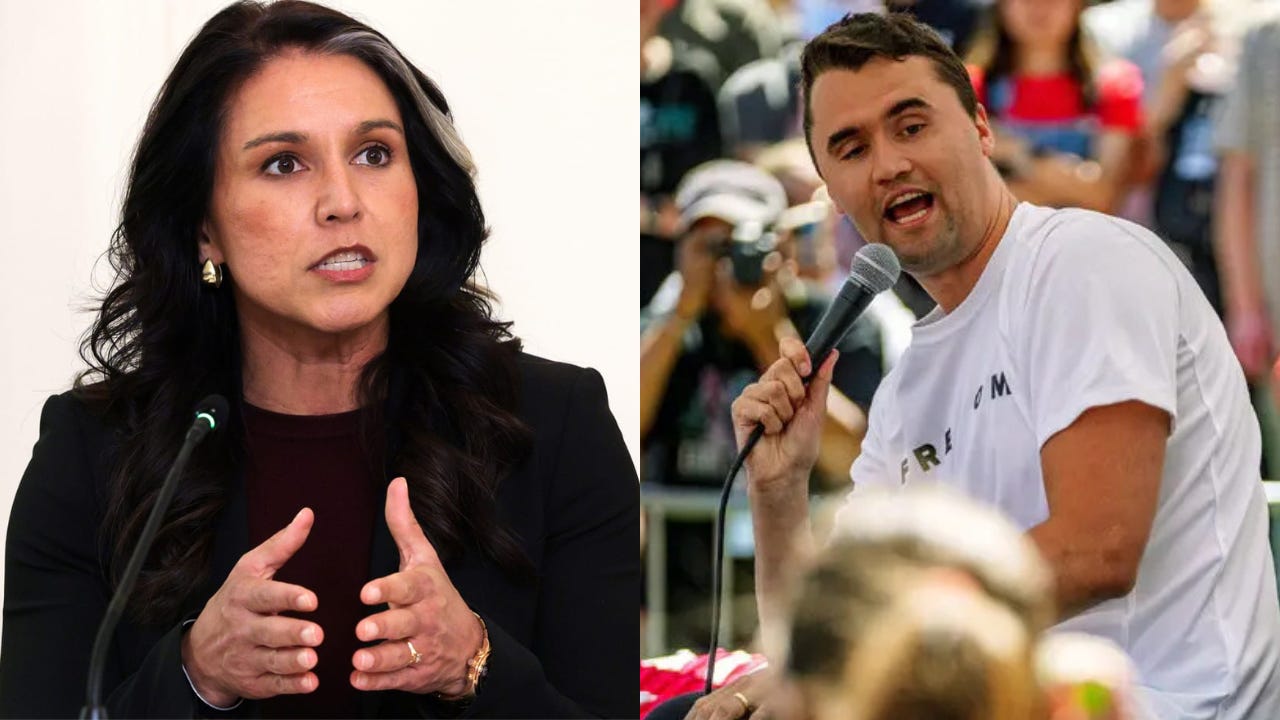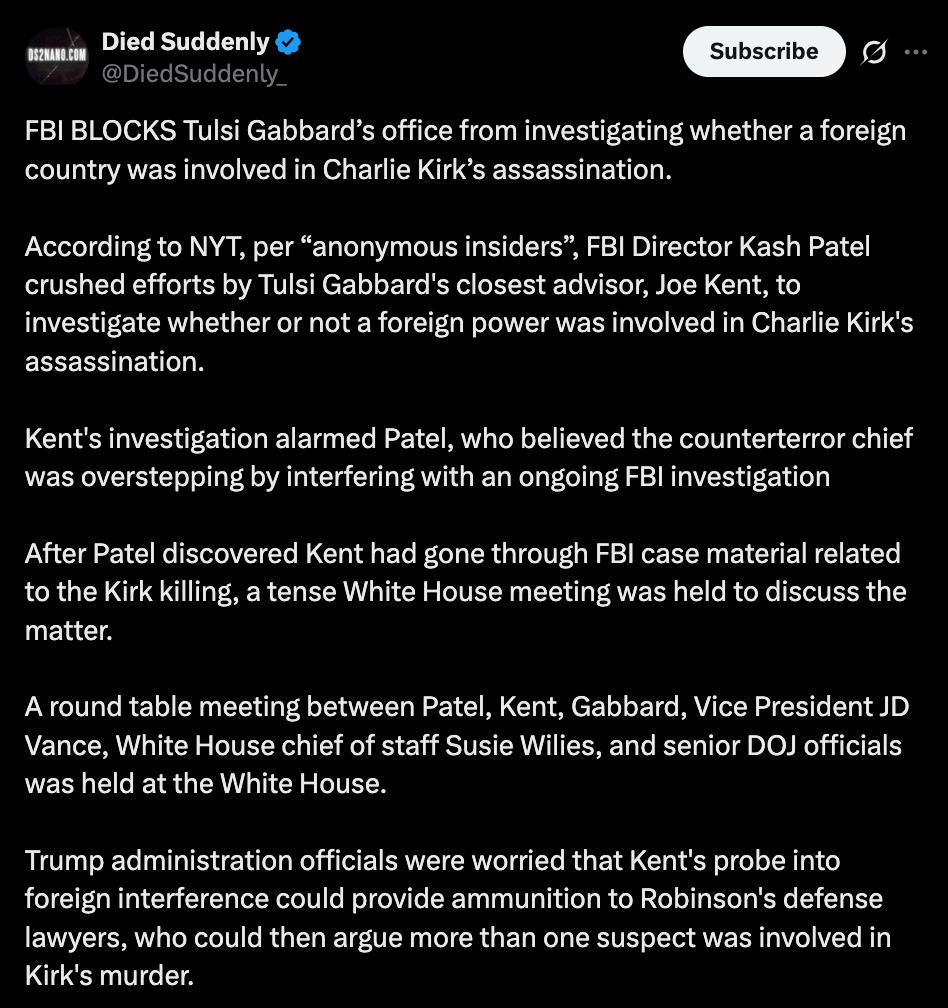FBI Blocks Investigation Into Foreign Involvment in Charlie Kirk Assassination Case
The Director saw it as interference,” one insider told The Times. “Kent was digging into classified channels and stepping on a live investigation.”
Click HERE to Claim Up to $10,000 in FREE Silver Before It’s Gone!
Washington, D.C. — The political earthquake following the assassination of conservative commentator Charlie Kirk has taken another stunning turn. A series of leaked briefings and insider accounts suggest that the FBI—under the direction of Kash Patel—blocked an independent probe by Rep. Tulsi Gabbard’s office into possible foreign involvement in the killing.
According to The New York Times, citing “anonymous insiders,” Patel personally ordered Gabbard’s senior advisor Joe Kent to stand down after discovering that Kent had accessed FBI case files tied to the Kirk investigation. The revelation has ignited a storm across Washington, reviving tensions between Trump-era national-security officials and the intelligence establishment.
Sources say Kent’s inquiries began after “irregular communications” surfaced between the primary suspect, Michael Robinson, and accounts traced to foreign servers. Gabbard’s team reportedly pushed to examine whether a hostile government could have played a role—an idea that reportedly rattled Patel and other intelligence veterans.
“The Director saw it as interference,” one insider told The Times. “Kent was digging into classified channels and stepping on a live investigation.”
What followed, according to multiple aides, was a tense White House showdown. In an emergency round-table, Patel met face-to-face with Gabbard, Kent, Vice President J.D. Vance, Chief of Staff Susie Wiles, and senior Department of Justice officials.
The meeting, described as “combustible,” centered on whether the Gabbard camp had overstepped by probing for foreign fingerprints before the Bureau had finished its own forensic sweep.
The standoff highlights a rare fracture within the Trump administration’s own ranks. Patel, a longtime loyalist elevated to FBI Director, reportedly feared that Kent’s investigation could jeopardize pending prosecutions. Insiders say the Justice Department worried Kent’s findings might hand defense lawyers ammunition to argue multiple actors were involved in the assassination.
Behind closed doors, aides described shouting matches over jurisdiction and motive. “It wasn’t about turf—it was about control of the story,” said one senior official familiar with the confrontation. “If Kent’s team could show evidence of foreign involvement, it would change everything about how the killing is being framed.”
Despite the gag order, whispers continue to swirl through D.C. corridors. Staffers claim that Kent’s internal memo—now circulating among congressional allies—points to communications routed through encrypted Eastern European servers. Analysts note that similar digital forensics were central to past high-profile political killings, including the 2018 Skripal poisoning and multiple NATO intelligence leaks.
The possibility of foreign interference, even tangential, would place the Kirk case at the intersection of espionage and domestic extremism—a volatile mix. Cybersecurity researchers and national-security scholars have long warned that politically charged assassinations can be exploited or even directed by outside powers seeking chaos inside the United States.
As pressure mounts, Gabbard’s office has gone quiet. Neither Kent nor Patel has issued public comment. But on Capitol Hill, lawmakers from both parties are demanding transparency. “If the Bureau blocked a legitimate congressional inquiry into potential foreign involvement in a domestic terror act,” one senior senator said, “that’s a constitutional crisis, not just a political fight.”
Meanwhile, online speculation has reached a fever pitch. Hashtags like #KirkFiles and #GabbardGate are trending across social platforms. Opinion hosts are already casting the conflict as a war between “the deep state and the reformers,” while insiders brace for further leaks from within the Justice Department itself.
Whether the standoff was a procedural clash or the cover-up of something far larger remains unclear. But one fact is now undeniable: the Kirk assassination has transformed from a shocking act of violence into a political thriller tearing at the very seams of Washington’s power structure—and the fallout is only just beginning.
This article is sponsored by Goldco, one of America’s most trusted precious metals companies. Right now, Goldco is helping readers protect their savings by offering a FREE Gold & Silver Investor’s Guide — plus, qualified new customers can receive up to $10,000 in FREE silver with their precious metals purchase.






This should say alot and raise the biggest red flag . This was all inside job anyway through and through.
History provides perspective.
Title: The Real History of Trusts
Subtitle: How a Hidden Legal Structure Became the Backbone of Power
Introduction (Overview of the Full Essay)
Across centuries, few legal instruments have shaped property, sovereignty, and wealth more profoundly than the trust. Though the modern world often associates trusts with wealthy heirs and carefully structured estates, their origins stretch into the dusty corners of medieval power and feudal control. Trusts are not merely financial tools; they are mechanisms designed to insulate the powerful from consequences, to maintain intergenerational dominance, and to separate those who appear to “own” property from those who truly control it.
I have spent years attempting to navigate and understand this cloaked legal labyrinth. Each layer I peeled back revealed yet another layer, as if some grand Kremlin doll was being slowly unpacked, daring me to see the tiny puppet-master hidden at the center. Trusts, I discovered, were not constructed to protect ordinary families—they were engineered to preserve elite prerogatives and protect ruling classes from accountability.
This essay will explore the historical evolution of trusts, from their feudal genesis to their modern role in global wealth preservation, all while demystifying the structure itself—grantor, trustee, beneficiary—and the duality between lawful and legal frameworks.
The complete work includes six themed sections, followed by a concluding analysis. Below is Part 1.
Part 1 — What a Trust Is and Why It Exists
Read more link:
https://prosepma.ca/forum/viewtopic.php?p=273#p273